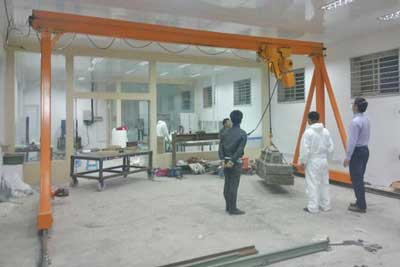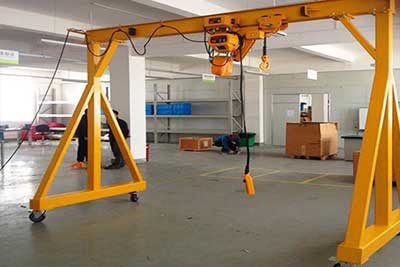2 Ton Gantry Cranes for Sale, Small-Scale Operations, Big Impact
Small-Scale Operations, Big Impact: 2 ton gantry cranes
In the world of material handling, efficiency and precision are paramount, regardless of the scale of your operations. Small-scale businesses and workshops often face unique challenges when it comes to moving materials and loads. Enter the unsung heroes of material handling in smaller settings: the 2 ton gantry cranes. In this two-part blog series, we'll explore how these compact yet powerful cranes make a big impact in small-scale operations and workshops.
Whether you're running a small manufacturing workshop, a modest warehouse, or a compact assembly line, the way you handle materials can have a significant impact on your productivity and bottom line. Efficient material handling is not a luxury; it's a necessity. When your space is limited, and resources are tight, making the most of what you have becomes essential. This is where 2 ton gantry cranes come into play.
An Overview on 2 Ton Gantry Cranes
Before we dive into their applications and advantages, let's get to know these cranes a bit better.
First and foremost, what are 2 ton gantry cranes? These cranes are a subset of gantry cranes known for their compact design and remarkable lifting capabilities. They are equipped with a single main beam, or "girder," running along the top of the crane, allowing them to efficiently lift loads weighing up to 2 tons.
The design of 2 ton gantry cranes is tailored to meet the needs of small-scale operations. They strike a balance between power and space-saving features, making them ideal for environments where room is limited.
These cranes consist of essential components, such as the girder, hoist, trolley, and control systems. The 2 ton lifting capacity makes them suitable for various applications, from moving raw materials in a workshop to supporting assembly processes.
Rail travelling gantry crane and rolling gantry crane are both types of cranes used for lifting and moving heavy loads. Here are some differences between the two:
- Mobility: A rail travelling gantry crane is designed to move along a set of rails installed on the ground or elevated tracks. It provides a fixed path for the crane to travel. On the other hand, a rolling gantry crane is equipped with wheels or casters, allowing it to move freely on the floor. It offers more flexibility in terms of movement.
- Load capacity: Both rail travelling gantry cranes and rolling gantry cranes can handle loads up to 2 tons. However, it's important to consider the specific model and design of the crane to ensure it meets your lifting requirements.
- Installation: Rail travelling gantry cranes require the installation of rails, which can be a more involved process. Rolling gantry cranes, on the other hand, can be easily moved and positioned without the need for any installation.
- Space requirement: Rail travelling gantry cranes require a dedicated space with installed rails, which may limit their use in certain environments. Rolling gantry cranes are more versatile and can be used in various locations without any specific infrastructure requirements.
Ultimately, the choice between a rail travelling gantry crane and a rolling gantry crane depends on your specific needs, available space, and mobility requirements.
Space-Saving Design for Small-Scale Facilities
Small-scale businesses and workshops often deal with spatial constraints. The beauty of 2 ton gantry cranes lies in their compact design, which allows them to operate effectively in confined spaces. Their single-girder configuration optimizes headroom, ensuring that you can make the most of your available vertical space.
Imagine a workshop with limited floor space. The ability to install a crane that efficiently moves materials and loads without occupying excessive room is a game-changer. These cranes are designed to fit seamlessly into your workspace, allowing you to maximize your floor area for other essential tasks.
Versatility in Handling Various Materials and Loads
The versatility of 2 ton gantry cranes knows no bounds. They are well-equipped to handle a wide range of materials and loads, making them invaluable tools for small-scale operations. From lifting machinery components to transporting raw materials, these cranes offer the flexibility you need.
In a manufacturing workshop, they can effortlessly move heavy machine parts, streamlining the assembly process. In a compact warehouse, they efficiently load and unload goods from shelves or storage racks. The ability to adapt to diverse tasks is one of the key advantages that sets these cranes apart.
Efficiency and Precision in Material Handling
Efficiency and precision are vital aspects of any successful operation, no matter the scale. 2 ton gantry cranes are engineered to provide both. With their 2 ton lifting capacity, they offer the power needed to handle materials effectively.
Their precise control and smooth operation mean that you can position loads with accuracy. This level of control is especially important in settings where components must align perfectly, such as in manufacturing and assembly. When time is money, the efficiency these cranes bring to the table can significantly impact your productivity.
Cost-Effectiveness for Budget-Conscious Operations
Small-scale operations often operate on tight budgets. The good news is that 2 ton gantry cranes are not only space-saving and efficient but also cost-effective. These cranes provide the lifting power you need without breaking the bank.
Compared to larger, more complex crane systems, the upfront cost of a 2 ton gantry crane is considerably more budget-friendly. Their lightweight design also results in lower energy consumption and maintenance costs, helping you optimize your budget without compromising on performance.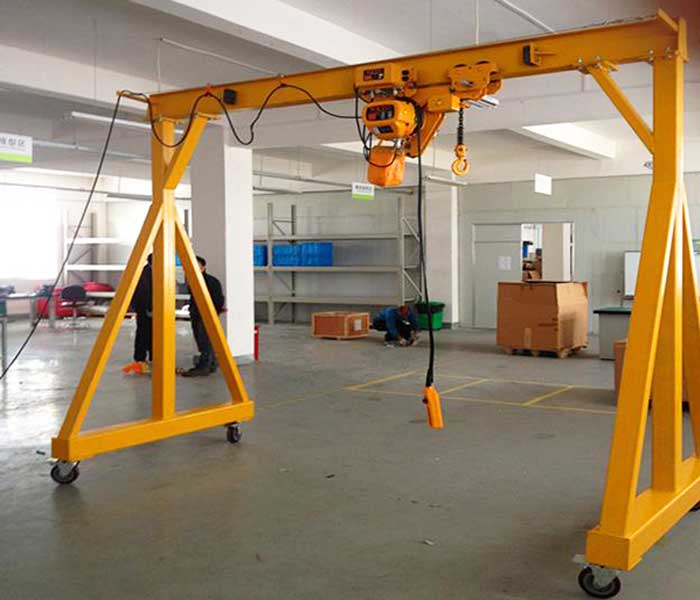
Portable gantry crane 2 ton customized for your particular need - Various types of portable gantry cranes for your selection
Applications and Use Cases
In the previous parts of our series, we've explored the world of 2 ton gantry cranes, their advantages, and how they can make a significant impact in small-scale operations and workshops. Now, let's dive into specific applications and use cases where these cranes prove their worth.
Material Handling in Small Workshops
Small workshops are bustling hubs of creativity and productivity, where every square inch of space matters. 2 ton gantry cranes are particularly well-suited for these environments. Their compact design allows them to move materials with precision and efficiency in confined spaces.
In a workshop setting, these cranes are often used for:
- Lifting Heavy Components: When assembling machinery or working on intricate projects, these cranes provide the power to lift heavy components into place with ease.
- Material Transport: Whether it's transporting raw materials, work-in-progress items, or finished products, these cranes streamline the movement of materials from one station to another.
- Tool Management: Managing heavy tools and equipment becomes more manageable, enhancing safety and productivity.
Supporting Assembly and Production Processes
In manufacturing and assembly environments, precision and speed are crucial. 2 ton gantry cranes offer the control and lifting capacity needed to support these processes effectively.
Applicaiton in assembly and production include:
- Machine Assembly: These cranes assist in positioning machine parts and components accurately during the assembly process.
- Production Line Support: They play a vital role in loading and unloading products along the production line, ensuring a smooth and efficient workflow.
- Workstation Mobility: These cranes are used to move heavy machinery or workstations as needed for various production tasks.
Loading and Unloading in Compact Storage Areas
Compact storage areas, such as warehouses and storage facilities with limited space, benefit from the material handling capabilities of 2 ton gantry cranes.
These cranes are employed for:
- Loading and Unloading: Efficiently loading and unloading goods from shelves, racks, and storage areas, even in tight spaces.
- Inventory Management: Supporting the organization and management of inventory, making it easier to access and handle stored items.
- Packing and Shipping: Simplifying the packing and shipping process by efficiently moving products to designated areas.
To illustrate the real-world impact of 2 ton gantry cranes, let's explore some case studies of successful implementations:
- Small Manufacturing Workshop: A small machine shop implemented a 2 ton gantry crane to lift heavy components during the assembly of specialized machinery. The crane increased assembly efficiency by 30% and improved overall workflow.
- Compact Warehouse: A compact warehouse used these cranes for loading and unloading goods from high storage racks. This resulted in a 40% reduction in loading time, minimizing downtime and enhancing productivity.
- Artisanal Workshop: An artisanal woodwork shop employed a 2 ton gantry crane to move heavy timber and finished products. The crane not only improved safety but also allowed for more precise positioning during woodworking tasks.
In these case studies, 2 ton gantry cranes provided practical solutions for small-scale operations, improving efficiency, safety, and overall performance.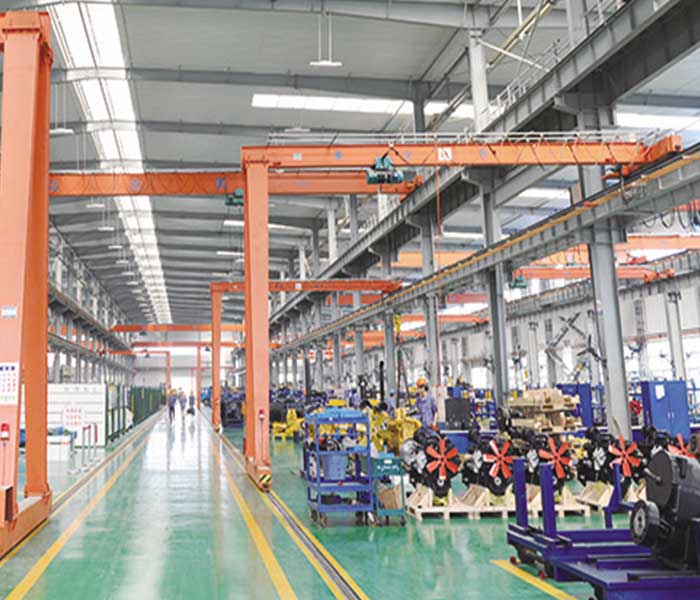
semi gantry crane 2 ton for small space workshop or facility
Factors to Consider When Choosing a 2 ton gantry crane
Choosing the right material handling equipment for your small-scale operation is crucial. In this part of our series, we'll explore the key factors to consider when selecting a 2 ton gantry crane. Making an informed choice ensures that the crane you choose aligns perfectly with your specific needs.
Evaluating Space and Headroom Requirements
Before investing in a 2 ton gantry crane, it's essential to assess your available space and headroom. These cranes are designed to be space-efficient, but you need to ensure they fit within your workspace without causing any obstructions.
Consider the following when evaluating space and headroom requirements:
- Available Floor Space: Measure the area where the crane will be placed to ensure it can operate without impeding other activities in your workspace.
- Headroom Clearance: Take into account the vertical space required for the crane to lift loads comfortably. Ensure there is sufficient overhead clearance to prevent collisions with ceilings or structures.
- Mobility: Think about the mobility of the crane. Does your workspace require the crane to be easily moved to different areas? If so, consider a crane with casters or wheels for added flexibility.
Customization Options to Meet Specific Needs
Every small-scale operation has unique requirements, and a one-size-fits-all solution may not be suitable. The ability to customize your 2 ton gantry crane to meet specific needs can be a game-changer.
Consider the following customization options:
- Lifting Attachments: Depending on the types of materials you handle, you may need specific lifting attachments. Customizing the crane with the right hooks, clamps, or other attachments can optimize your material handling.
- Control Systems: Explore control options that match your preferences. From manual controls to advanced remote systems, choose what suits your operational style and safety requirements.
- Paint and Coating: Consider the environment in which the crane will operate. Opt for suitable paint and coatings that provide protection against corrosion and wear, especially if the crane will be used in challenging conditions.
Safety Features and Operator Training
Safety is paramount when it comes to operating any heavy equipment, and 2 ton gantry cranes are no exception. Ensuring that the crane is equipped with essential safety features is crucial to protect both operators and the workplace.
Prioritize the following safety considerations:
- Overload Protection: Look for cranes equipped with overload protection systems to prevent the crane from attempting to lift loads exceeding its capacity, reducing the risk of accidents.
- Emergency Stop Function: Ensure the crane has an emergency stop function, allowing immediate halting of operations in case of an emergency or when safety is compromised.
- Operator Training: Proper operator training is essential. Make sure that operators receive comprehensive training to handle the crane safely and efficiently. Training should cover crane operation, load handling, and safety protocols.
Maintenance and Care - Ensuring Your 2 ton gantry crane's Longevity
Your 2 ton gantry crane is an essential part of your small-scale operation. To keep it operating smoothly and safely, it's crucial to implement a regular maintenance and care routine. In this part of our series, we'll explore the steps you can take to ensure the longevity of your crane.
Regular Inspections and Preventative Maintenance
Regular inspections and preventative maintenance are key to keeping your 2 ton gantry crane in optimal working condition. By addressing issues early and preventing potential problems, you can extend the crane's lifespan and maintain its efficiency.
Here's what you need to do:
- Scheduled Inspections: Establish a routine inspection schedule to check for signs of wear, loose bolts, and any potential issues. This should include a thorough examination of the crane's components, such as the hoist, trolley, and gantry structure.
- Lubrication: Keep the crane well-lubricated to reduce friction and prevent premature wear. Regularly lubricate moving parts, such as wheels, gears, and pulleys.
- Bolt Tightening: Ensure that all bolts and fasteners are securely tightened. Loose bolts can compromise the crane's stability and safety.
- Electrical Systems: Inspect the electrical components of the crane, such as the wiring, controls, and emergency stop systems, to ensure they are functioning correctly.
Addressing Common Issues and Wear and Tear
Over time, wear and tear are inevitable, but addressing common issues promptly can prevent them from becoming major problems. Here are some common issues to watch out for:
- Worn Cables: The lifting cables can experience wear and damage. Regularly check for fraying or kinks and replace damaged cables as needed.
- Worn Wheels and Rails: The wheels and rails that the crane travels on can wear down with use. If you notice uneven wear or damage, consider replacing them to maintain smooth movement.
- Hoist Malfunctions: Keep an eye on the hoist's performance. If it starts to exhibit unusual behavior, such as jerky movements or difficulty lifting loads, it's important to investigate and address the issue promptly.
- Corrosion: If your crane operates in a corrosive environment, regularly inspect the crane for signs of corrosion. Implement rust prevention measures and apply appropriate coatings to protect the crane's structural integrity.
Importance of Operator Training for Safe Operation
No maintenance routine can fully replace the importance of well-trained crane operators. Operator training is crucial for ensuring safe and efficient crane operation. Well-trained operators can spot issues early, operate the crane correctly, and contribute to its longevity.
Operator training should cover:
- Safe Operation: Proper crane operation techniques to ensure the safety of both operators and those in the vicinity.
- Load Handling: Techniques for handling various loads safely and efficiently, including how to balance and secure loads properly.
- Emergency Protocols: Procedures for handling emergency situations, such as equipment malfunctions or accidents, ensuring the safety of all personnel.
- Regular Inspection: Training on how to conduct routine inspections and identify potential issues that require maintenance or repair.
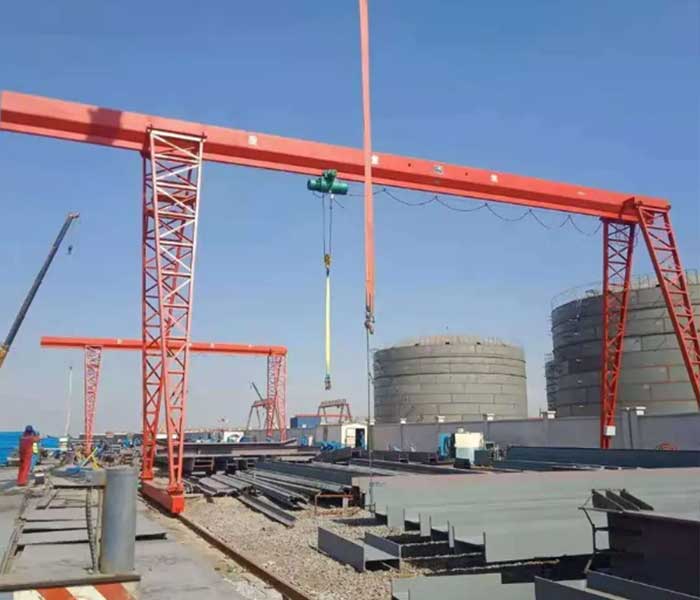
Single girder gantry crane 2 ton for indoor and outdoor use
Cost Considerations - Making Informed Investment Choices
In this section of our series on 2 ton gantry cranes, we'll delve into the crucial aspect of cost considerations. Understanding the financial implications of your crane investment is essential for making informed choices that align with your small-scale operation's budget and long-term goals.
Initial Investment and Pricing Factors
The initial investment in a 2 ton gantry crane is a significant consideration for any small-scale operation. Several pricing factors come into play:
- Capacity and Features: The lifting capacity and additional features of the crane, such as customized attachments or control systems, can impact the upfront cost.
- Brand and Manufacturer: Reputable brands and manufacturers may command a higher price due to their quality and reliability. Consider the value they provide in terms of long-term performance.
- Customization: Customizing the crane to meet specific needs may come with added costs. Evaluate the benefits of customization against the budget.
- Installation and Setup: Costs associated with the crane's installation, assembly, and setup should be factored into the initial investment.
Total Cost of Ownership (TCO) for Long-Term Budget Planning
While the initial investment is important, it's equally crucial to consider the Total Cost of Ownership (TCO) when budget planning. TCO accounts for all costs associated with the crane throughout its lifecycle, including operating, maintenance, and eventual replacement costs. This comprehensive approach helps you make more informed financial decisions.
To calculate TCO, consider:
- Operating Costs: This includes expenses related to energy consumption, maintenance, and any ongoing operational expenses.
- Maintenance and Repairs: Regular maintenance and addressing wear and tear are necessary. Include these costs in your TCO calculations.
- Replacement and Upgrades: Factor in the potential need for replacement or upgrades over the crane's lifespan. Assess how this affects the overall TCO.
- Long-Term Performance: Consider how the crane's performance impacts your operations and productivity. A more efficient crane may reduce labor and operational costs.
Comparing the Cost-Effectiveness to Other Crane Options
When considering a 2 ton gantry crane, it's essential to assess its cost-effectiveness compared to other crane options. While the upfront cost may be lower, the crane's performance, longevity, and efficiency should be evaluated to determine its true value.
Consider the following in your cost-effectiveness analysis:
- Performance: How does the crane's performance stack up against other options? Assess its lifting capacity, precision, and overall efficiency.
- Longevity: Evaluate the crane's expected lifespan and how it compares to other crane types. A longer-lasting crane may provide better overall value.
- Maintenance Costs: Compare the maintenance costs of the 2 ton gantry crane to those of other cranes. Lower maintenance costs can result in cost savings over time.
- Operational Efficiency: Determine how the crane's efficiency impacts your daily operations. A more efficient crane may reduce labor costs and increase productivity.
In this section on 2 ton gantry cranes, we've delved into cost considerations to help you make informed investment choices for your small-scale operation. By understanding the initial investment, calculating the Total Cost of Ownership (TCO), and comparing the cost-effectiveness to other crane options, you can ensure that your crane investment aligns with your budget and long-term goals.
Careful financial planning and assessment of costs will lead to a more cost-effective and value-driven crane solution for your small-scale operation.
Wrap it up,
In this comprehensive series, we've explored the world of 2 ton gantry cranes and uncovered their remarkable impact on small-scale operations and workshops. Let's recap the advantages of these cranes, emphasize their significant contributions to small-scale operations, and encourage potential users to consider them for efficient material handling in their facilities.
Throughout this series, we've highlighted the many advantages of 2 ton gantry cranes:
- Space Efficiency: Their compact design makes them ideal for confined workspaces, allowing you to maximize your available are
- Versatility: These cranes can handle a wide range of materials and loads, adapting to the diverse needs of small-scale operations.
- Efficiency and Precision: Their precise control and smooth operation make material handling efficient and accurate.
- Cost-Effectiveness: They offer cost-effective solutions without compromising on performance.
- Safety: Equipped with safety features, these cranes protect both operators and the workspace.
2 ton gantry cranes may be compact in size, but their impact is substantial. In small-scale operations and workshops, these cranes become invaluable assets:
- They streamline material handling in small workshops, improving efficiency and organization.
- They support assembly and production processes by providing precision and lifting capacity.
- They facilitate loading and unloading in compact storage areas, optimizing space utilization.
- Through case studies, we've seen real-world examples of how these cranes have significantly improved small-scale operations.
If you're seeking efficient material handling solutions for your small-scale operation or workshop, we encourage you to consider 2 ton gantry cranes. Their space-saving design, versatility, efficiency, and cost-effectiveness make them a perfect fit for your needs.
By implementing these cranes, you can enhance your workflow, boost productivity, and ensure safe material handling within your workspace. The impact of these cranes in small-scale operations cannot be overstated, and their advantages extend far beyond their compact size.
Make an informed choice for your material handling needs and consider the value that 2 ton gantry cranes bring to your facility. Your small-scale operation will undoubtedly benefit from their remarkable capabilities.


